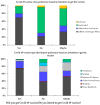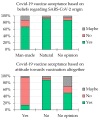Psychological Determinants of COVID-19 Vaccine Acceptance among Healthcare Workers in Kuwait: A Cross-Sectional Study Using the 5C and Vaccine Conspiracy Beliefs Scales
- PMID: 34202298
- PMCID: PMC8310287
- DOI: 10.3390/vaccines9070701
Psychological Determinants of COVID-19 Vaccine Acceptance among Healthcare Workers in Kuwait: A Cross-Sectional Study Using the 5C and Vaccine Conspiracy Beliefs Scales
Abstract
Acceptance of coronavirus disease 2019 (COVID-19) vaccination appears as a decisive factor necessary to control the ongoing pandemic. Healthcare workers (HCWs) are among the highest risk groups for infection. The current study aimed to evaluate COVID-19 vaccine acceptance among HCWs in Kuwait, with identification of the psychological determinants of COVID-19 vaccine hesitancy. The study was conducted using an online anonymous survey distributed between 18 March 2021 and 29 March 2021. The sampling strategy was convenience-based depending on chain-referral sampling. Psychological determinants of COVID-19 vaccine acceptance were assessed using the 5C subscales and the Vaccine Conspiracy Beliefs Scale (VCBS). The total number of study participants was 1019, with the largest group being physicians (28.7%), pharmacists (20.2%), dentists (16.7%), and nurses (12.5%). The overall rate for COVID-19 vaccine acceptance was 83.3%, with 9.0% who were not willing to accept vaccination and 7.7% who were unsure. The highest rate for COVID-19 vaccine acceptance was seen among dentists (91.2%) and physicians (90.4%), while the lowest rate was seen among nurses (70.1%; p < 0.001). A higher level of COVID-19 vaccine hesitancy was found among females, participants with a lower educational level, and HCWs in the private sector. A preference for mRNA vaccine technology and Pfizer-BioNTech COVID-19 vaccine was found among the majority of participants (62.6% and 69.7%, respectively). COVID-19 vaccine hesitancy was significantly linked to the embrace of vaccine conspiracy beliefs. The highest 5C psychological predictors of COVID-19 vaccine acceptance were high levels of collective responsibility and confidence, and lower levels of constraints and calculation. The VCBS and 5C subscales (except the calculation subscale) showed acceptable levels of predicting COVID-19 vaccine acceptance based on receiver operating characteristic analyses. The participants who depended on social media platforms, TV programs, and news releases as their main sources of knowledge about COVID-19 vaccines showed higher rates of COVID-19 vaccine hesitancy. An overall satisfactory level of COVID-19 vaccine acceptance was seen among HCWs in Kuwait, which was among the highest rates reported globally. However; higher levels of vaccine hesitancy were observed among certain groups (females, nurses and laboratory workers, HCWs in the private sector), which should be targeted with more focused awareness programs. HCWs in Kuwait can play a central role in educating their patients and the general public about the benefits of COVID-19 vaccination to halt the spread of SARS-CoV-2, considering the high rates of vaccine hesitancy observed among the general public in Kuwait and the Middle East.
Keywords: SARS-CoV-2 prevention; anti-vaccine; intention to vaccinate; vaccine hesitancy; vaccine rejection.
Conflict of interest statement
The authors declare no conflict of interest.
Figures








Similar articles
-
The Role of Psychological Factors and Vaccine Conspiracy Beliefs in Influenza Vaccine Hesitancy and Uptake among Jordanian Healthcare Workers during the COVID-19 Pandemic.Vaccines (Basel). 2022 Aug 19;10(8):1355. doi: 10.3390/vaccines10081355. Vaccines (Basel). 2022. PMID: 36016243 Free PMC article.
-
High Rates of COVID-19 Vaccine Hesitancy and Its Association with Conspiracy Beliefs: A Study in Jordan and Kuwait among Other Arab Countries.Vaccines (Basel). 2021 Jan 12;9(1):42. doi: 10.3390/vaccines9010042. Vaccines (Basel). 2021. PMID: 33445581 Free PMC article.
-
Qatar Healthcare Workers' COVID-19 Vaccine Hesitancy and Attitudes: A National Cross-Sectional Survey.Front Public Health. 2021 Aug 25;9:727748. doi: 10.3389/fpubh.2021.727748. eCollection 2021. Front Public Health. 2021. PMID: 34513792 Free PMC article.
-
Knowledge about, attitude and acceptance towards, and predictors of intention to receive the COVID-19 vaccine among cancer patients in Eastern China: A cross-sectional survey.J Integr Med. 2022 Jan;20(1):34-44. doi: 10.1016/j.joim.2021.10.004. Epub 2021 Oct 26. J Integr Med. 2022. PMID: 34774463 Free PMC article. Review.
-
COVID-19 vaccine hesitancy among healthcare workers in Arab Countries: A systematic review and meta-analysis.PLoS One. 2024 Jan 2;19(1):e0296432. doi: 10.1371/journal.pone.0296432. eCollection 2024. PLoS One. 2024. PMID: 38166119 Free PMC article.
Cited by
-
Parental perceptions and the 5C psychological antecedents of COVID-19 vaccination during the first month of omicron variant surge: A large-scale cross-sectional survey in Saudi Arabia.Front Pediatr. 2022 Aug 16;10:944165. doi: 10.3389/fped.2022.944165. eCollection 2022. Front Pediatr. 2022. PMID: 36052364 Free PMC article.
-
Global COVID-19 vaccine acceptance rate: a systematic review and meta-analysis.Z Gesundh Wiss. 2022 Sep 26:1-13. doi: 10.1007/s10389-022-01757-5. Online ahead of print. Z Gesundh Wiss. 2022. PMID: 36188446 Free PMC article. Review.
-
Effect of elderly individuals' perceptions and attitudes toward COVID-19 pandemic on rejecting COVID-19 vaccination.Hum Vaccin Immunother. 2022 Nov 30;18(5):2079338. doi: 10.1080/21645515.2022.2079338. Epub 2022 Jun 10. Hum Vaccin Immunother. 2022. PMID: 35687362 Free PMC article.
-
The Role of Psychological Factors and Vaccine Conspiracy Beliefs in Influenza Vaccine Hesitancy and Uptake among Jordanian Healthcare Workers during the COVID-19 Pandemic.Vaccines (Basel). 2022 Aug 19;10(8):1355. doi: 10.3390/vaccines10081355. Vaccines (Basel). 2022. PMID: 36016243 Free PMC article.
-
Willingness to get HPV vaccination among female university students in Kuwait and its relation to vaccine conspiracy beliefs.Hum Vaccin Immunother. 2023 Dec 31;19(1):2194772. doi: 10.1080/21645515.2023.2194772. Epub 2023 Apr 2. Hum Vaccin Immunother. 2023. PMID: 37005342 Free PMC article.
References
-
- The World Health Organization (WHO) Ten Threats to Global Health in 2019. [(accessed on 12 April 2021)]; Available online: https://www.who.int/news-room/spotlight/ten-threats-to-global-health-in-....
LinkOut - more resources
Full Text Sources
Miscellaneous

